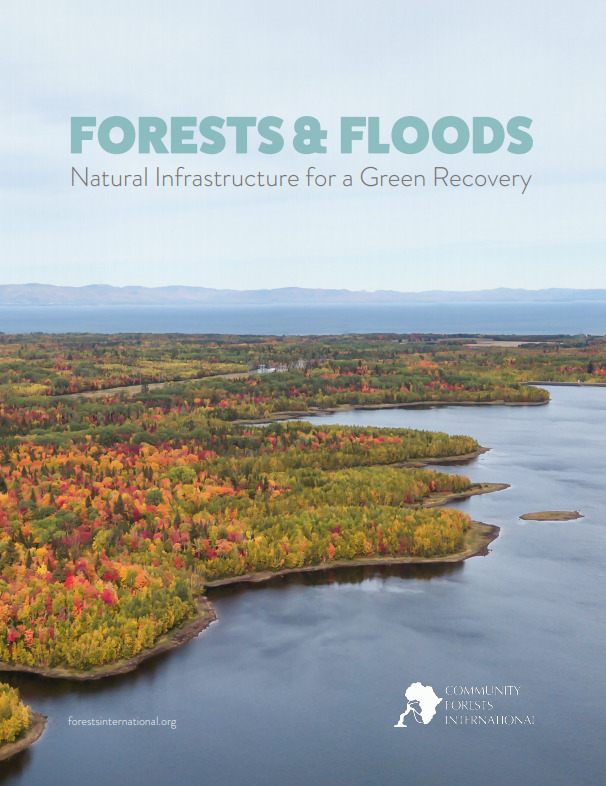Forests & Floods
By Community Forests International, Posted on June 15, 2021
Updated May 2023 to include new research from the Intact Centre on Climate Adaptation at the University of Waterloo.
Community Forests International’s new report, Forests and Floods: Natural Infrastructure for a Green Recovery, highlights the important role that forests could play in reducing flood risk in New Brunswick and similarly impacted regions in Canada. The report is part of a larger organization initiative—and a wider movement in the sector—to establish a clear economic case for protecting forests for the ecosystem services they provide to nearby communities.
“Forests support communities by directly protecting them against the impacts of climate change.”
– Daimen Hardie, Executive Director
The necessity for transformational investments in Canada’s COVID-19 response today runs parallel to the need for investment in climate change adaptation and green growth. Extreme weather linked to climate change continues to intensify — creating physical shocks that threaten the country’s social and economic stability. For Canada, investing in vital natural infrastructure presents opportunities to contribute to green economic recovery from the pandemic while simultaneously increasing long-term climate resilience and disaster risk reduction.
Research Findings

A comprehensive hydrologic study conducted on a 350-acre mature Wabanaki forest along the Canaan River, which flows into the Wolastoq (Saint John) River Watershed, yielded significant insights. The study found that in the face of a 1:100-year storm event, with a 20% increase in rainfall intensity due to climate change, replacing the peak flow attenuation services of the forest in the study area alone would require built infrastructure, such as catchment ponds, exceeding a staggering 25,900 cubic meters. The cost of such infrastructure would exceed $1,000,000, far surpassing the estimated $285,000 value of the timber harvested from the area. These findings underline the indisputable business case for utilizing forests as natural infrastructure solutions.
The business case for forest infrastructure solutions
During heavy rainfall, forests act as nature’s sponges, efficiently storing water within their ecosystem and gradually releasing it into streams and rivers. A recent analysis by the Municipal Natural Assets Initiative (MNAI) highlighted the flood attenuation replacement value of riparian forests, revealing that achieving the same flood attenuation through artificial infrastructure would cost approximately $30,250 per hectare. In contrast, the top-level fair market value based solely on forest harvest revenues stands at a mere $1,000 per hectare. These compelling figures clearly demonstrate the financial advantage of exploring forests as a natural infrastructure solution.
Forests: our greatest climate solution
Over the past decade, Canada has witnessed a distressing rise in catastrophic losses caused by extreme weather events. The Insurance Bureau of Canada reports average losses exceeding $1.8 billion between 2009 and 2017. With nearly 10% of Canadians residing in high-risk flood areas, flooding remains one of the most significant climate change-related threats to the country, affecting not only the economy but also the social and mental well-being of impacted communities.
Forests show great promise for acting as natural infrastructure to mitigate flood damage. During heavy rainfall, forests soak up and store water, releasing it slowly into streams and rivers and helping to mitigate the risk of flooding. In the latest flood report from the Intact Centre on Climate Adaptation at the University of Waterloo, nature-based solutions are cheaper and more effective at managing these issues.
Despite the tremendous potential forests hold for mitigating flood risks, New Brunswick alone has witnessed the loss of over a third of its forest in the last 25 years. This extensive deforestation has resulted in a fragmented and youthful forest landscape, compromising local climate change resiliency and essential ecosystem services. To unlock the vast potential of our forests for flood risk mitigation, we need to protect the remaining forests, restore degraded forestlands, and shift away from business-as-usual forest management.
Keep Reading
To learn more about the link between forests and flooding, watch our Lunch & Learn session created in collaboration with WWF and the Nashwaak Watershed Association, or download the full Forests & Floods Report here.
This research was funded by Intact Financial. We gratefully also acknowledge support from the Intact Centre on Climate Adaptation at the University of Waterloo, as well as valuable insights and research provided by Dr. Charles Bourque and Antóin O’Sullivan from the University of New Brunswick, and Simon Mitchell from WWF-Canada.

